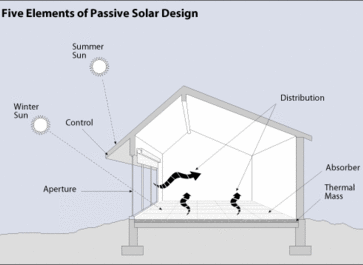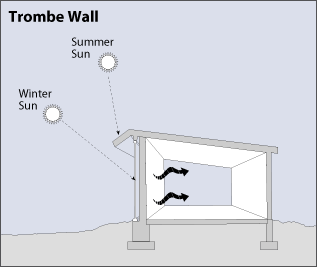
The following five elements constitute a complete passive solar home design. Each performs a separate function, but all five must work together for the design to be successful.
The large glass (window) area through which sunlight enters the building. Typically, the aperture(s) should face within 30 degrees of true south and should not be shaded by other buildings or trees from 9 a.m. to 3 p.m. each day during the heating season.
The hard, darkened surface of the storage element. This surface—which could be that of a masonry wall, floor, or partition (phase change material), or that of a water container—sits in the direct path of sunlight. Sunlight hits the surface and is absorbed as heat. At night, as the room cools, the heat stored in the thermal mass convects and radiates into the room.
The materials that retain or store the heat produced by sunlight. The difference between the absorber and thermal mass, although they often form the same wall or floor, is that the absorber is an exposed surface whereas thermal mass is the material below or behind that surface. An option is to use a trombe wall which is a dark masonry wall behind glass on the south side, transporting heat at slow speed to the interior so it arrives after the sun is down.
The method by which solar heat circulates from the collection and storage points to different areas of the house. A strictly passive design will use the three natural heat transfer modes—conduction, convection, and radiation—exclusively. In some applications, however, fans, ducts, and blowers may help with the distribution of heat through the house.
Roof overhangs or trees that have leaves in summer, but are bare in winter, can be used to shade the aperture area during summer months. Other elements that control under- and/or overheating include electronic sensing devices, such as a differential thermostat that signals a fan to turn on; operable vents and dampers that allow or restrict heat flow; low-emissivity blinds; and awnings.

Comments by our Users
Be the first to write a comment for this item.